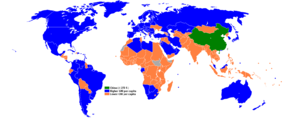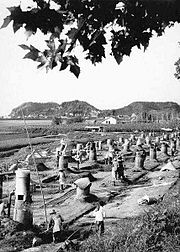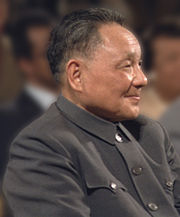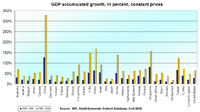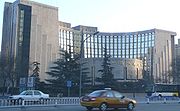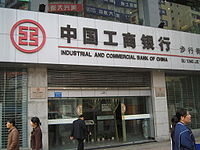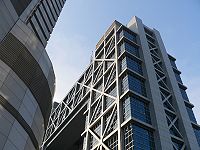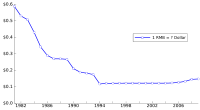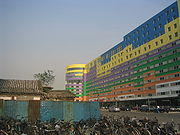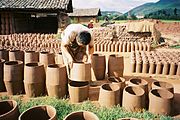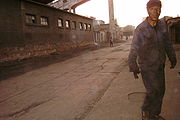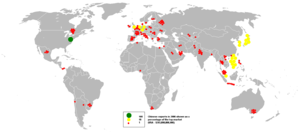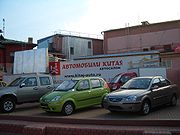
Economy of the People's Republic of China
Background Information
This content from Wikipedia has been selected by SOS Children for suitability in schools around the world. Click here for more information on SOS Children.
| Economy of People's Republic of China | |
|---|---|
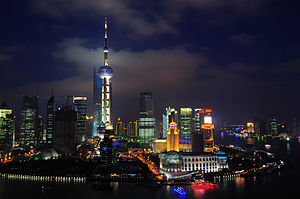 Pudong in Shanghai |
|
| Rank | 2nd (nominal) / 2nd (PPP) |
| Currency | Renminbi (RMB); Unit: Yuan (CNY) |
| Fixed exchange rates | USD = 6.305 RMB (average in 2012) |
| Fiscal year | Calendar year 01 January to 31 December |
| Trade organisations | WTO, APEC, G-20 and others |
| Statistics | |
| GDP |
$8.24 trillion (nominal: ) $12.38 trillion (PPP: 2nd; 2012) |
| GDP growth | 7.8% (2012) |
| GDP per capita |
$4,700 (nominal: 90th; 2011) |
| GDP by sector | agriculture: 9.7%, industry: 46.6%, services: 43.7%% (2012 est.) CIA - The World Factbook |
| Inflation ( CPI) | 2.5% (December 2012) |
| Population below poverty line |
less than $1.25 / 13.1% (2008) less than $2 / 29.8% (2008) |
| Gini coefficient | 0.48 |
| Labour force | 795.5 million ( 1st; 2010) |
| Labour force by occupation |
agriculture: 36.7%, industry: 28.7%, services: 34.6% (2008 est.) |
| Unemployment | 4.1% (Q4 2012) |
| Average gross salary | $457 monthly (2010) |
| Main industries | World leader in gross value of industrial output; mining and ore processing, iron, steel, aluminium, and other metals, coal; machine building; armaments; textiles and apparel; petroleum; cement; chemicals; fertilizers; consumer products, including footwear, toys, and electronics; food processing; transportation equipment, including automobiles, rail cars and locomotives, ships, and aircraft; telecommunications equipment, commercial space launch vehicles, satellites |
| Ease of Doing Business Rank | 91st |
| External | |
| Exports | $1.904 trillion (2011 est.) |
| Export goods | Electrical and other machinery, including data processing equipment, apparel, textiles, iron and steel, optical and medical equipment |
| Main export partners | US 17.1%, Hong Kong 14.1%, Japan 7.8%, South Korea 4.4%, Germany 4% (2011) |
| Imports | $1.743 trillion (2011 est.) |
| Import goods | Electrical and other machinery, oil and mineral fuels, optical and medical equipment, metal ores, plastics, organic chemicals |
| Main import partners | Japan 11.2%, South Korea 9.3%, US 6.8%, Germany 5.3%, Australia 4.6% (2011) |
| FDI stock | $116 billion (2011) |
| Gross external debt | $697.2 billion (30 September 2011 est.) |
| Public finances | |
| Public debt | 22.15% of GDP (2012) |
| Revenues | $1.838 trillion (2012 est.) |
| Expenses | $2.031 trillion (2012 est.) |
| Economic aid | recipient: $1.12 per capita (2008) |
| Credit rating | AA- (Domestic) AA- (Foreign) AA- (T&C Assessment) ( Standard & Poor's) |
| Foreign reserves | $3.28 trillion (1st; Sep 2012) |
|
Main data source: CIA World Fact Book |
|
The People's Republic of China (PRC) is the world's second largest economy by nominal GDP and by purchasing power parity after the United States. It is the world's fastest-growing major economy, with growth rates averaging 10% over the past 30 years. China is also the largest exporter and second largest importer of goods in the world.
On a per capita income basis, China ranked 90th by nominal GDP and 91st by GDP (PPP) in 2011, according to the International Monetary Fund (IMF). The provinces in the coastal regions of China tend to be more industrialized, while regions in the hinterland are less developed. As China's economic importance has grown, so has attention to the structure and health of the economy.
As the Chinese economy is internationalized, so does the standardized economic forecast officially launched in China by Purchasing Managers Index in 2005. Most economic growth of China is created from Special Economic Zones of the People's Republic of China. The construction of the road system of Beijing–Shanghai Expressway was completed and opened to public usage in early 2000 for access of transportation on logistics, travel and tourism around the most populous and densely economic active areas of Chinese Mainland.
History
By 1949, continuous foreign invasions, frequent revolutions and restorations, and civil wars had left the country with a fragile economy with little infrastructure. As Communist ascendancy seemed inevitable, almost all hard and foreign currency in China country were transported to Taiwan in 1948, making the war-time inflation even worse.
Since the formation of the PRC, an enormous effort was made towards creating economic growth and entire new industries were created. Tight control of budget and money supply reduced inflation by the end of 1950. Though most of it was done at the expense of suppressing the private sector of small to big businesses by the Three-anti/five-anti campaigns between 1951 to 1952. The campaigns were notorious for being anti-capitalist, and imposed charges that allowed the government to punish capitalists with severe fines. In the beginning of the Communist party's rule, the leaders of the party had agreed that for a nation such as China, which does not have any heavy industry and minimal secondary production, capitalism is to be utilized to help the building of the "New China" and finally merged into communism.
The new government nationalized the country's banking system and brought all currency and credit under centralized control. It regulated prices by establishing trade associations and boosted government revenues by collecting agricultural taxes. By the mid-1950s, the communists had ruined the country's railroad and highway systems, barely brought the agricultural and industrial production to their prewar levels, by bringing the bulk of China's industry and commerce under the direct control of the state.
Meanwhile, in fulfillment of their revolutionary promise, China's communist leaders completed land reform within two years of coming to power, eliminating landlords and redistribute their land and other possessions to peasant households.
Mao tried in 1958 to push China's economy to new heights. Under his highly touted " Great Leap Forward", agricultural collectives were reorganized into enormous communes where men and women were assigned in military fashion to specific tasks. Peasants were told to stop relying on the family, and instead adopted a system of communal kitchens, mess halls, and nurseries. Wages were calculated along the communist principle of " From each according to his ability, to each according to his need", and sideline production was banned as incipient capitalism. All Chinese citizens were urged to boost the country's steel production by establishing "backyard steel furnaces" to help overtake the West. The Great Leap Forward quickly revealed itself as a giant step backwards. Over-ambitious targets were set, falsified production figures were duly reported, and Chinese officials lived in an unreal world of miraculous production increases. By 1960, agricultural production in the countryside had slowed dangerously and large areas of China were gripped by a devastating famine.
For the next several years, China experienced a period of relative stability. Agricultural and industrial production returned to normal levels, and labor productivity began to rise. Then, in 1966, Mao proclaimed a Cultural Revolution to "put China back on track". Under orders to "Destroy the Four Olds" (old thoughts, culture, customs and habits), universities and schools closed their doors, and students, who became Mao's " Red Guards", were sent throughout the country to make revolution, beating and torturing anyone whose rank or political thinking offended. By 1969 the country had descended into anarchy, and factions of the Red Guards had begun to fight among themselves.
1978–1990
Reforms began with Li Xiannian and Deng Xiaoping, Chinese leaders in the 80s. Unlike Mao, Deng and Li were pragmatic leaders, known less for their ideological commitment than for their slogan: "Who cares if a cat is black or white, as long as it catches the mice." Once they consolidated their power, they began to put their pragmatic policies to work, determined to bring China back from the devastation that the Cultural Revolution had wrought.
Since 1978, China began to make major reforms to its economy. The Chinese leadership adopted a pragmatic perspective on many political and socioeconomic problems, and quickly began to introduce aspects of a capitalist economic system. Political and social stability, economic productivity, and public and consumer welfare were considered paramount and indivisible. In these years, the government emphasized raising personal income and consumption and introducing new management systems to help increase productivity. The government also had focused on foreign trade as a major vehicle for economic growth. In the 1980s, China tried to combine central planning with market-oriented reforms to increase productivity, living standards, and technological quality without exacerbating inflation, unemployment, and budget deficits. Reforms began in the agricultural, industrial, fiscal, financial, banking, price setting, and labor systems.
A decision was made in 1978 to permit foreign direct investment in several small " special economic zones" along the coast. The country lacked the legal infrastructure and knowledge of international practices to make this prospect attractive for many foreign businesses, however. In the early 1980s steps were taken to expand the number of areas that could accept foreign investment with a minimum of red tape, and related efforts were made to develop the legal and other infrastructures necessary to make this work well. This additional effort resulted in making 14 coastal cities and three coastal regions "open areas" for foreign investment. All of these places provide favored tax treatment and other advantages for foreign investment. Laws on contracts, patents, and other matters of concern to foreign businesses were also passed in an effort to attract international capital to spur China's development. The largely bureaucratic nature of China's economy, however, posed a number of inherent problems for foreign firms that wanted to operate in the Chinese environment, and China gradually had to add more incentives to attract foreign capital.
Phase One: reform in the countryside
After Mao Zedong came into power, China's vast peasantry was organized in communes, work brigades, and production teams. Procurement prices were too low to cover even production costs, and ceilings were set on the amount of grain that producers could keep for consumption. Deng allowed farmers to produce on their own and sanctioned the sale of surplus production and other cash crops in newly freed markets. State procurement prices were raised, and prices for many agricultural goods were left to the dictates of the market. Beginning with the poor mountain areas of Anhui and then spreading across the country, Deng and his officials broke up the communes established by Mao and replaced them with a complicated system of leases that eventually brought effective land tenure back to the household level, even though ownership of land remained collective. The Household Responsibility System allowed peasants to lease land for a fixed period from the collective, provided they delivered to the collective a minimum quota of produce, usually basic grain. They could then sell any surplus they produced, either to the state at government procurement prices or on the newly free market. They were also permitted to retain any profits they might earn. Within a decade, grain production had grown by roughly 30%, and production of cotton, sugarcane, tobacco, and fruit had doubled.
Phase Two: rural industrialization and enterprise reform
As the reforms fueled production increases that surprised even the reformers, the scale of change grew bolder, and by the mid-1980s, the party leadership had begun the more complicated and politically delicate task of transforming the country's system of central planning and state-owned enterprise. Prior to 1978, enterprises were almost all owned by the state in one form or another. At the top of each sector were the State-owned Enterprises (SOEs), answerable to the national government. Below these were other enterprises reporting to provincial, municipal, or county authorities. Private enterprises, meaning family-run shops, were not allowed until after 1978, and even then they were limited to seven employees.
China's SOEs were typical of large industrial firms in a centrally planned economy. They functioned not only as industrial units but also as social agencies, providing housing, daycare, education, and health care for the workers and their families. The largest enterprises included hundreds of thousands of employees, only a small proportion of whom were directly engaged in production.
The update of this system was that Chinese workers could expect both lifetime employment and an extensive, firm-based welfare system-the so-called "iron rice bowl". All welfare entitlements in this system were accounted for as costs of production and were deducted from revenues before the calculation of the profits that were to be remitted to the state. There was no national social security system because none was needed.
1990–2000

In the 1990s, the Chinese economy continued to grow at a rapid pace, at about 9.5%, accompanied by a rapidly increasing inflation, which reached over 20 percent in 1994. The Asian financial crisis affected China at the margin, mainly through decreased foreign direct investment and a sharp drop in the growth of its exports. However, China had huge reserves, a currency that was not freely convertible, and capital inflows that consisted overwhelmingly of long-term investment. For these reasons it remained largely insulated from the regional crisis and its commitment not to devalue had been a major stabilizing factor for the region. However, China faced slowing growth and rising unemployment based on internal problems, including a financial system burdened by huge amounts of bad loans, and massive layoffs stemming from aggressive efforts to reform state-owned enterprises (SOEs).
Despite China's impressive economic development during the past two decades, reforming the state sector and modernizing the banking system remained major hurdles. Over half of China's state-owned enterprises were inefficient and reporting losses. During the 15th National Communist Party Congress that met in September 1997, President Jiang Zemin announced plans to sell, merge, or close the vast majority of SOEs in his call for increased "non-public ownership" (feigongyou or privatization.) The 9th National People's Congress endorsed the plans at its March 1998 session. In 2000, China claimed success in its three-year effort to make the majority of large state owned enterprises (SOEs) profitable.
2000–2010
Following the Chinese Communist Party's Third Plenum, held in October 2003, Chinese legislators unveiled several proposed amendments to the state constitution. One of the most significant was a proposal to provide protection for private property rights. Legislators also indicated there would be a new emphasis on certain aspects of overall government economic policy, including efforts to reduce unemployment (now in the 8–10% range in urban areas), to rebalance income distribution between urban and rural regions, and to maintain economic growth while protecting the environment and improving social equity. The National People's Congress approved the amendments when it met in March 2004.
The Fifth Plenum in October 2005 approved the 11th Five-Year Economic Program (2006–2010) aimed at building a " socialist harmonious society" through more balanced wealth distribution and improved education, medical care, and social security. On March 2006, the National People's Congress approved the 11th Five-Year Program. The plan called for a relatively conservative 45% increase in GDP and a 20% reduction in energy intensity (energy consumption per unit of GDP) by 2010.
China's economy grew at an average rate of 10% per year during the period 1990–2004, the highest growth rate in the world. China's GDP grew 10.0% in 2003, 10.1%, in 2004, and even faster 10.4% in 2005 despite attempts by the government to cool the economy. China's total trade in 2010 surpassed $2.97 trillion, making China the world's second-largest trading nation after the U.S. Such high growth is necessary if China is to generate the 15 million jobs needed annually—roughly the size of Ecuador or Cambodia—to employ new entrants into the national job market.
On January 14, 2009, as confirmed by the World Bank the NBS published the revised figures for 2007 fiscal year in which growth happened at 13 percent instead of 11.9 percent (provisional figures). China's gross domestic product stood at US$3.38 trillion while Germany's GDP was USD $3.32 trillion for 2007. This made China the world's third largest economy by gross domestic product. Based on these figures, in 2007 China recorded its fastest growth since 1994 when the GDP grew by 13.1 percent.
China launched its Economic Stimulus Plan to specifically deal with the Global financial crisis of 2008–2009. It has primarily focused on increasing affordable housing, easing credit restrictions for mortgage and SMEs, lower taxes such as those on real estate sales and commodities, pumping more public investment into infrastructure development, such as the rail network, roads and ports. By the end of 2009 it appeared that the Chinese economy was showing signs of recovery. At the 2009 Economic Work Conference in December 'managing inflation expectations' was added to the list of economic objectives, suggesting a strong economic upturn and a desire to take steps to manage it.
2010–present
By 2010 it was evident to outside observers such as The New York Times that China was poised to move from export dependency to development of an internal market. Wages were rapidly rising in all areas of the country and Chinese leaders were calling for an increased standard of living.
| Wikinews has related news: China's economy surpasses Japan's in second quarter |
In 2010, China's GDP was valued at $5.87 trillion, surpassed Japan's $5.47 trillion, and became the world's second largest economy after the U.S. China could become the world's largest economy (by nominal GDP) sometime as early as 2020.
China is the largest creditor nation in the world and owns approximately 20.8% of all foreign-owned US Treasury securities.
It has also appeared that Noopolitik and the knowledge economy had become salient interests of the PRC's economic policy across the 2000s, through which the country made clear its move from "Made in China" to "Innovated in China" as notes Adam Segal. Idriss Aberkane thus argued "With China's cosmopolitan and highly educated diaspora, it is no surprise that as of 2010, five of the top twenty most visited websites in the world are indexed in Mandarin. They include PRC-born behemoths such as Baidu.com, Taobao.com, and Sina.com.cn, and video sharing Tudou.com, which has gained users in both North America and Europe."
The Institute of Economic Research of Renmin University of China has conducted several studies and released several reports regarding China's economy. "Under the influences of 2009's stimulus policies, the spread of the economic bubble and implementation of the "12th Five-Year Plan", China was at a key stage of steering the economic recovery to stable growth. While prices increased steadily, China's GDP went back to the high-level growth rate and its economic structure gradually became market-oriented.". The foremost authorities on the Chinese economy -- those within the Chinese think-tanks and government -- give a unique, first-hand perspective. Their works, translated into English for a Western audience, are published only through an independent Hong Kong publishing house, Enrich Professional Publishing (EPP), and can be found at academic libraries throughout the world.
The World Bank's chief economist Justin Lin in 2011 stated that China, which became the world's second largest economy in 2010, may become the world's largest economy in 2030, overtaking the United States, if current trends continue. Challenges include income inequality and pollution. The Standard Chartered Bank in a 2011 report suggested that China may become the world's largest economy in 2020. A 2007 OECD rapport by Angus Maddison estimated that if using purchasing power parity conversions, then China will overtake the United States in 2015. James Wolfensohn, former World Bank president, estimated in 2010 that by 2030 two-thirds of the world's middle class will live in China. The Director of the China Centre for Economic Reform at Peking University Yao Yang in 2011 stated that "Assuming that the Chinese and U.S. economies grow, respectively, by 8% and 3% in real terms, that China's inflation rate is 3.6% and America's is 2% (the averages of the last decade), and that the renminbi appreciates against the dollar by 3% per year (the average of the last six years), China would become the world's largest economy by 2021. By that time, both countries' GDP will be about $24 trillion."
In 2011, the IMF warned that government controlled banks could be building up imbalances that could hamper growth and leave the system "severely impacted". In 2011, the IMF predicted that China's GDP ( purchasing power parity adjusted) would overtake that of the United States in 2016. The state favours state-owned enterprises despite lower productivity; this crowds out competition, in a phenomenon known as Guo jin min tui.
From 2011 onward, however, China has been experiencing a slowing of its growth that throws all of the above calculations into doubt. Ray Dalio, founder of the worldest largest hedge fund, told the Council of Foreign Relations that he foresaw Chinese GDP falling to 4-5% due to failure to switch successfully from the export-driven model to more consumption.
In 2012, Amnesty International reported that forced evictions that resulted from a construction boom caused by excessive stimulus spending were a serious threat to China's social and political stability.
Due to the corruption and political uncertainties of the one-party state and the limited economic freedom in an economy dominated by large state owned enterprises, many skilled professionals are either leaving the country or preparing safety nets for themselves abroad. Corruption continued to grow worse in the PRC as it dropped from 75th to 80th place in Transparency International's index of state corruption.
A law approved February 2013 will mandate a nationwide minimum wage at 40% average urban salaries to be phased in fully by 2015.
Government role
Since 1949 the government, under socialist political and economic system, has been responsible for planning and managing the national economy. In the early 1950s, the foreign trade system was monopolized by the state. Nearly all the domestic enterprises were state-owned and the government had set the prices for key commodities, controlled the level and general distribution of investment funds, determined output targets for major enterprises and branches, allocated energy resources, set wage levels and employment targets, operated the wholesale and retail networks, and steered the financial policy and banking system. In the countryside from the mid-1950s, the government established cropping patterns, set the level of prices, and fixed output targets for all major crops.
Since 1978 when economic reforms were instituted, the government's role in the economy has lessened by a great degree. Industrial output by state enterprises slowly declined, although a few strategic industries, such as the aerospace industry have today remained predominantly state-owned. While the role of the government in managing the economy has been reduced and the role of both private enterprise and market forces increased, the government maintains a major role in the urban economy. With its policies on such issues as agricultural procurement the government also retains a major influence on rural sector performance. The State Constitution of 1982 specified that the state is to guide the country's economic development by making broad decisions on economic priorities and policies, and that the State Council, which exercises executive control, was to direct its subordinate bodies in preparing and implementing the national economic plan and the state budget. A major portion of the government system (bureaucracy) is devoted to managing the economy in a top-down chain of command with all but a few of the more than 100 ministries, commissions, administrations, bureaus, academies, and corporations under the State Council being concerned with economic matters.
Each significant economic sector is supervised by one or more of these organizations, which includes the People's Bank of China, National Development and Reform Commission, Ministry of Finance, and the ministries of agriculture; coal industry; commerce; communications; education; light industry; metallurgical industry; petroleum industry; railways; textile industry; and water resources and electric power. Several aspects of the economy are administered by specialized departments under the State Council, including the National Bureau of Statistics, Civil Aviation Administration of China, and the tourism bureau. Each of the economic organizations under the State Council directs the units under its jurisdiction through subordinate offices at the provincial and local levels.
The whole policy-making process involves extensive consultation and negotiation. Economic policies and decisions adopted by the National People's Congress and the State Council are to be passed on to the economic organizations under the State Council, which incorporates them into the plans for the various sectors of the economy. Economic plans and policies are implemented by a variety of direct and indirect control mechanisms. Direct control is exercised by designating specific physical output quotas and supply allocations for some goods and services. Indirect instruments—also called "economic levers"—operate by affecting market incentives. These included levying taxes, setting prices for products and supplies, allocating investment funds, monitoring and controlling financial transactions by the banking system, and controlling the allocation of key resources, such as skilled labor, electric power, transportation, steel, and chemicals (including fertilizers). The main advantage of including a project in an annual plan is that the raw materials, labor, financial resources, and markets are guaranteed by directives that have the weight of the law behind them. In reality, however, a great deal of economic activity goes on outside the scope of the detailed plan, and the tendency has been for the plan to become narrower rather than broader in scope. A major objective of the reform program was to reduce the use of direct controls and to increase the role of indirect economic levers. Major state-owned enterprises still receive detailed plans specifying physical quantities of key inputs and products from their ministries. These corporations, however, have been increasingly affected by prices and allocations that were determined through market interaction and only indirectly influenced by the central plan.
Total economic enterprise in China is apportioned along lines of directive planning (mandatory), indicative planning (indirect implementation of central directives), and those left to market forces. In the early 1980s during the initial reforms enterprises began to have increasing discretion over the quantities of inputs purchased, the sources of inputs, the variety of products manufactured, and the production process. Operational supervision over economic projects has devolved primarily to provincial, municipal, and county governments. The majority of state-owned industrial enterprises, which were managed at the provincial level or below, were partially regulated by a combination of specific allocations and indirect controls, but they also produced goods outside the plan for sale in the market. Important, scarce resources—for example, engineers or finished steel—may have been assigned to this kind of unit in exact numbers. Less critical assignments of personnel and materials would have been authorized in a general way by the plan, but with procurement arrangements left up to the enterprise management.
In addition, enterprises themselves are gaining increased independence in a range of activity. While strategically important industry and services and most of large-scale construction have remained under directive planning, the market economy has gained rapidly in scale every year as it subsumes more and more sectors. Overall, the Chinese industrial system contains a complex mixture of relationships. The State Council generally administers relatively strict control over resources deemed to be of vital concern for the performance and health of the entire economy. Less vital aspects of the economy have been transferred to lower levels for detailed decisions and management. Furthermore, the need to coordinate entities that are in different organizational hierarchies generally causes a great deal of informal bargaining and consensus building.
Consumer spending has been subject to a limited degree of direct government influence but is primarily determined by the basic market forces of income levels and commodity prices. Before the reform period, key goods were rationed when they were in short supply, but by the mid-1980s availability had increased to the point that rationing was discontinued for everything except grain, which could also be purchased in the free markets. Collectively owned units and the agricultural sector were regulated primarily by indirect instruments. Each collective unit was "responsible for its own profit and loss", and the prices of its inputs and products provided the major production incentives.
Vast changes were made in relaxing the state control of the agricultural sector from the late 1970s. The structural mechanisms for implementing state objectives—the people's communes and their subordinate teams and brigades—have been either entirely eliminated or greatly diminished. Farm incentives have been boosted both by price increases for state-purchased agricultural products, and it was permitted to sell excess production on a free market. There was more room in the choice of what crops to grow, and peasants are allowed to contract for land that they will work, rather than simply working most of the land collectively. The system of procurement quotas (fixed in the form of contracts) has been being phased out, although the state can still buy farm products and control surpluses in order to affect market conditions.
Foreign trade is supervised by the Ministry of Commerce, customs, and the Bank of China, the foreign exchange arm of the Chinese banking system, which controls access to the foreign currency required for imports. Ever since restrictions on foreign trade were reduced, there have been broad opportunities for individual enterprises to engage in exchanges with foreign firms without much intervention from official agencies.
State-owned enterprises
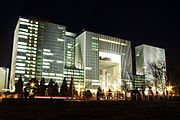
As of 2012 large state-owned enterprises (SOEs) were the backbone of China's economy producing over 50% of its goods and services and employing over half of the workers in China. 65 of the Chinese companies in the 2012 Fortune Global 500 list, were state-owned, including State Grid Corporation of China, which operates the country's power grid, and China National Petroleum Corporation and Sinopec, oil companies. Profits of the largest state-owned enterprises were much greater than the largest firms in the private sector which were largely small and medium sized businesses. Reform efforts, spurred by problems with corruption at some firms, were focused on splitting state-owned firms or creating competing state-owned firms rather than privatization which is politically unacceptable to the ruling party. Firms attempting to maintain their position such as the State Grid point out the advantages of monopoly, using examples of disorganization such as the 2012 India blackouts. As of 2011, 35% of business activity and 43% of profits in the People's Republic of China resulted from companies in which the state owned a majority interest. Liberal critics, such as The New York Times, allege that China's state-owned companies are a vehicle for corruption by the families of ruling party leaders who have sometimes amassed fortunes while managing them.
Regional economies
China's unequal transportation system—combined with important differences in the availability of natural and human resources and in industrial infrastructure—has produced significant variations in the regional economies of China.
Economic development has generally been more rapid in coastal provinces than in the interior, and there are large disparities in per capita income between regions. The three wealthiest regions are along the southeast coast, centred on the Pearl River Delta; along the east coast, centred on the Lower Yangtze River; and near the Bohai Gulf, in the Beijing–Tianjin– Liaoning region. It is the rapid development of these areas that is expected to have the most significant effect on the Asian regional economy as a whole, and Chinese government policy is designed to remove the obstacles to accelerated growth in these wealthier regions.
Hong Kong and Macau
In accordance with the One Country, Two Systems policy, the economies of the former European colonies, Hong Kong and Macau, are separate from the rest of the PRC, and each other. Both Hong Kong and Macau are free to conduct and engage in economic negotiations with foreign countries, as well as participating as full members in various international economic organizations such as the World Customs Organization, the World Trade Organization and the Asia-Pacific Economic Cooperation forum, often under the names "Hong Kong, China" and "Macau, China".
Development
China, economically frail before 1978, has again become one of the world's major economic powers with the greatest potential. In the 22 years following reform and opening-up in 1979 in particular, China's economy developed at an remarkable rate, and that momentum was maintained into the early years of the 21st century.
China adopts the " five-year-plan" strategy for economic development. The Twelfth Five-Year Plan (2011–2015) is currently being implemented.
Like Japan and South Korea before it, for nearly 30 years China has indeed been growing, thrusting its citizens into prosperity and its goods across the world. Between 1978 and 2005, China's per capita GDP had grown from $153 to $1284, while its current account surplus had increased over twelve-fold between 1982 and 2004, from $5.7 billion to $71 billion. During this time, China had also become an industrial powerhouse, moving beyond initial successes in low-wage sectors like clothing and footwear to the increasingly sophisticated production of computers, pharmaceuticals, and automobiles.
Just how long the trajectory could continue, however, remained unclear. According to the 11th five-year plan, China needed to sustain an annual growth rates of 8% for the foreseeable future. Only with such levels of growth, the leadership argued, could China continue to develop its industrial prowess, raise its citizen's standard of living, and redress the inequalities that were cropping up across the country. Yet no country had ever before maintained the kind of growth that China was predicting. Moreover, China had to some extent already undergone the easier parts of development. In the 1980s, it had transformed its vast and inefficient agricultural sector, freeing its peasants from the confines of central planning and winning them to the cause of reform. In the 1990s, it had likewise started to restructure its stagnant industrial sector, wooing foreign investors for the first time. These policies had catalysed the country's phenomenal growth. Instead, China had to take what many regarded as the final step toward the market, liberalizing the banking sector and launching the beginnings of a real capital market.
This step, however, would not be easy. As of 2004, China's state-owned enterprises were still only partially reorganized, and its banks were dealing with the burden of over $205 billion (1.7 trillion RMB) in non-performing loans, monies that had little chance of ever being repaid. The country had a floating exchange rate, and strict controls on both the current and capital accounts.
Regional development
These strategies are aimed at the relatively poorer regions in China in an attempt to prevent widening inequalities:
- China Western Development, designed to increase the economic situation of the western provinces through capital investment and development of natural resources.
- Revitalize Northeast China, to rejuvenate the industrial bases in Northeast China. It covers the three provinces of Heilongjiang, Jilin, and Liaoning, as well as the five eastern prefectures of Inner Mongolia.
- Rise of Central China Plan, to accelerate the development of its central regions. It covers six provinces: Shanxi, Henan, Anhui, Hubei, Hunan, and Jiangxi.
- Third Front, focused on the southwestern provinces.
Foreign investment abroad:
- Go Global, to encourage its enterprises to invest overseas.
Key national projects
The "West-to-East Electricity Transmission", the "West-to-East Gas Transmission", and the " South–North Water Transfer Project" are the government's three key strategic projects, aimed at realigning overall economic development and achieving rational distribution of national resources across China. The "West-to-East Electricity Transmission" project is in full swing, involving hydropower and coal resources in western China and the construction of new power transmission channels to deliver electricity to the east. The southern power grid line, transmitting three million kW from Guizhou to Guangdong, was completed in September 2004. The "West-to-East Gas Transmission" project includes a 4,000 km trunk pipeline running through 10 provinces, autonomous regions or municipalities, conveying natural gas to cities in northern and eastern China. This was finished in October 2004 and has a design capacity of 12 billion cu m per year. Construction of the "South-to-North Water Diversion" project was officially launched on 27 December 2002 and completion of Phase I is scheduled for 2010; this will relieve serious water shortfall in northern China and realize a rational distribution of the water resources of the Yangtze, Yellow, Huaihe, and Haihe river valleys.
Macroeconomic trends
In January 1985, the State Council of China approved to establish a SNA (System of National Accounting), use the gross domestic product (GDP) to measure the national economy. China started the study of theoretical foundation, guiding, and accounting model etc., for establishing a new system of national economic accounting. In 1986, as the first citizen of the People's Republic of China to receive a Ph.D. in economics from an overseas country, Dr. Fengbo Zhang headed Chinese Macroeconomic Research – the key research project of the seventh Five-Year Plan of China, as well as completing and publishing the China GDP data by China's own research. The summary of the above has been included in the book Chinese Macroeconomic Structure and Policy (1988) Editor: Fengbo Zhang, collectively authored by the Research Centre of the State Council of China. This is the first GDP data which was published by China. The State Council of China issued "The notice regarding implementation of System of National Accounting" in August 1992, the SNA system officially is introduced to China, replaced Soviet Union's MPS system, Western economic indicator GDP became China's most important economic indicator ( WikiChina: China GDP, The First China GDP).
The table below shows the trend of the GDP of China at market prices estimated by the International Monetary Fund (IMF) with figures in millions ( Chinese yuan). See also. For purchasing power parity comparisons, the US dollar is exchanged at 2.05 CNY only.
| Year | Gross domestic product | US dollar exchange | Inflation index (2000=100) |
Nominal Per Capita GDP (as % of USA) |
PPP Per Capita GDP (as % of USA) |
|---|---|---|---|---|---|
| 1955 | 91,000 | 2.46 | 19.2 | 2.43 | - |
| 1960 | 145,700 | 2.46 | 20.0 | 3.04 | - |
| 1965 | 171,600 | 2.46 | 21.6 | 2.63 | - |
| 1970 | 225,300 | 2.46 | 21.3 | 2.20 | - |
| 1975 | 299,700 | 1.86 | 22.4 | 2.32 | - |
| 1980 | 460,906 | 1.49 | 25.0 | 2.52 | 2.04 |
| 1985 | 896,440 | 2.93 | 30.0 | 1.65 | 2.84 |
| 1990 | 1,854,790 | 4.78 | 49.0 | 1.48 | 3.43 |
| 1995 | 6,079,400 | 8.35 | 91.0 | 2.17 | 5.44 |
| 2000 | 9,921,500 | 8.27 | 100.0 | 2.69 | 6.75 |
| 2005 | 18,308,500 | 8.19 | 106.0 | 4.05 | 9.61 |
| 2010 | 25,506,956 | 6.97 | 112.0 | 6.23 | 15.90 |
Systemic problems
The government has in recent years struggled to contain the social strife and environmental damage related to the economy's rapid transformation; collect public receipts due from provinces, businesses, and individuals; reduce corruption and other economic crimes; sustain adequate job growth for tens of millions of workers laid off from state-owned enterprises, migrants, and new entrants to the work force; and keep afloat the large state-owned enterprises, most of which had not participated in the vigorous expansion of the economy and many of which had been losing the ability to pay full wages and pensions. From 50 to 100 million surplus rural workers were adrift between the villages and the cities, many subsisting through part-time low-paying jobs. Popular resistance, changes in central policy, and loss of authority by rural cadres have weakened China's population control program. Another long-term threat to continued rapid economic growth has been the deterioration in the environment, notably air and water pollution, soil erosion, growing desertification and the steady fall of the water table especially in the north. China also has continued to lose arable land because of erosion and infrastructure development.
Other major problems concern the labor force and the pricing system. There is large-scale underemployment in both urban and rural areas, and the fear of the disruptive effects of major, explicit unemployment is strong. The prices of certain key commodities, especially of industrial raw materials and major industrial products, are determined by the state. In most cases, basic price ratios were set in the 1950s and are often irrational in terms of current production capabilities and demands. Over the years, large subsidies were built into the price structure, and these subsidies grew substantially in the late 1970s and 1980s. By the early 1990s these subsidies began to be eliminated, in large part due to China's admission into the World Trade Organization (WTO) in 2001, which carried with it requirements for further economic liberalization and deregulation.
By 2010, rapidly rising wages and a general increase in the standard of living had put increased energy use on a collision course with the need to reduce carbon emissions in order to control global warming. There were diligent efforts to increase energy efficiency and increase use of renewable sources; over 1,000 inefficient power plants had been closed, but projections continued to show a dramatic rise in carbon emissions from burning fossil fuels.
Regulatory environment
Though China's economy has expanded rapidly, its regulatory environment has not kept pace. Since Deng Xiaoping's open market reforms, the growth of new businesses has outpaced the government's ability to regulate them. This has created a situation where businesses, faced with mounting competition and poor oversight, take drastic measures to increase profit margins, often at the expense of consumer safety. This issue became more prominent in 2007, with a number of restrictions being placed on problematic Chinese exports by the United States.
Inflation
During the winter of 2007–2008, inflation ran about 7% on an annual basis, rising to 8.7% in statistics for February 2008, released in March 2008.
Shortages of gasoline and diesel fuel developed in the fall of 2007 due to reluctance of refineries to produce fuel at low prices set by the state. These prices were slightly increased in November 2007 with fuel selling for $2.65 a gallon, still slightly below world prices. Price controls were in effect on numerous basic products and services, but were ineffective with food, prices of which were rising at an annual rate of 18.2% in November 2007. The problem of inflation has caused concern at the highest levels of the Chinese government. On January 9, 2008, the government of China issued the following statement on its official website: "The Chinese government decided on Wednesday to take further measures to stabilize market prices and increase the severity of punishments for those guilty of driving up prices through hoarding or cheating."
Pork is an important part of the Chinese economy with a per capita consumption of a fifth of a pound per day. The worldwide rise in the price of animal feed associated with increased production of ethanol from corn resulted in steep rises in pork prices in China in 2007. Increased cost of production interacted badly with increased demand resulting from rapidly rising wages. The state responded by subsidizing pork prices for students and the urban poor and called for increased production. Release of pork from the nation's strategic pork reserve was considered.
By January 2008, the inflation rate rose to 7.1%, which BBC News described as the highest inflation rate since 1997, due to the winter storms that month. China's inflation rate jumped to a new decade high of 8.7 percent in February 2008 after severe winter storms disrupted the economy and worsened food shortages, the government said March 11, 2008.
Throughout the summer and fall, however, inflation fell again to a low of 6.6% in October 2008.
By November 2010, the inflation rate rose up to 5.1%, driven by a 11.7% increase in food prices year on year. According to the bureau, industrial output went up 13.3 percent. As supplies have run short, prices for fuel and other commodities have risen.
Investment cycles
Chinese investment has always been highly cyclical. Ever since the 1958 Great Leap Forward, growth in fixed capital formation has typically peaked about every five years. Recent peaks occurred in 1978, 1984, 1988, 1993, 2003, and 2009. The corresponding troughs were in 1981, 1986, 1989, 1997, and 2005.
In China, the majority of investment is carried out by entities that are at least partially state-owned. Most of these are under the control of local governments. Thus booms are primarily the result of perverse incentives at the local-government level.
Unlike entrepreneurs in a free-enterprise economy, Chinese local officials are motivated primarily by political considerations. As their performance evaluations are based, to a large extent, on GDP growth within their jurisdictions, they have a strong incentive to promote large-scale investment projects. They also don’t face any real bankruptcy risk. When localities get into trouble, they are invariably bailed out by state-owned banks. Under these circumstances, overinvestment is inevitable.
A typical cycle begins with a relaxation of central government credit and industrial policy. This allows local governments to push investment aggressively, both through state-sector entities they control directly and by offering investment-promotion incentives to private investors and enterprises outside their jurisdictions.
The resulting boom puts upward pressure on prices and may also result in shortages of key inputs such as coal and electricity (as was the case in 2003).Once inflation has risen to a level at which it begins to threaten social stability, the central government will intervene by tightening enforcement of industrial and credit policy. Projects that went ahead without required approvals will be halted. Bank lending to particular types of investors will be restricted. Credit then becomes tight and investment growth begins to decline.
Eventually such centrally-imposed busts alleviate shortages and bring inflation down to acceptable levels. At that point, the central government yields to local-government demands for looser policy and the cycle begins again.
Financial and banking system
Most of China's financial institutions are state owned and governed and 98% of banking assets are state owned. The chief instruments of financial and fiscal control are the People's Bank of China (PBC) and the Ministry of Finance, both under the authority of the State Council. The People's Bank of China replaced the Central Bank of China in 1950 and gradually took over private banks. It fulfills many of the functions of other central and commercial banks. It issues the currency, controls circulation, and plays an important role in disbursing budgetary expenditures. Additionally, it administers the accounts, payments, and receipts of government organizations and other bodies, which enables it to exert thorough supervision over their financial and general performances in consideration to the government's economic plans. The PBC is also responsible for international trade and other overseas transactions. Remittances by overseas Chinese are managed by the Bank of China (BOC), which has a number of branch offices in several countries.
Other financial institutions that are crucial, include the China Development Bank (CDB), which funds economic development and directs foreign investment; the Agricultural Bank of China (ABC), which provides for the agricultural sector; the China Construction Bank (CCB), which is responsible for capitalizing a portion of overall investment and for providing capital funds for certain industrial and construction enterprises; and the Industrial and Commercial Bank of China (ICBC), which conducts ordinary commercial transactions and acts as a savings bank for the public.
China's economic reforms greatly increased the economic role of the banking system. In theory any enterprises or individuals can go to the banks to obtain loans outside the state plan, in practice 75% of state bank loans go to State Owned Enterprises. (SOEs) Even though nearly all investment capital was previously provided on a grant basis according to the state plan, policy has since the start of the reform shifted to a loan basis through the various state-directed financial institutions. It is estimated that, as of 2011, 14 trillion renminbi in loans were outstanding to local governments. Much of that total is believed by outside observers to be nonperforming. Increasing amounts of funds are made available through the banks for economic and commercial purposes. Foreign sources of capital have also increased. China has received loans from the World Bank and several United Nations programs, as well as from countries (particularly Japan) and, to a lesser extent, commercial banks. Hong Kong has been a major conduit of this investment, as well as a source itself. On 23 February 2012, the PBC evinced its inclination to liberalise its capital markets when it circulated a telling ten-year timetable. Following on the heels of this development, Shenzhen banks were able to launch cross-border yuan remittances for individuals, a significant shift in the PBC's capital control strictures since Chinese nationals had been previously barred from transferring their yuan to overseas account.
With two stock exchanges ( Shanghai Stock Exchange and Shenzhen Stock Exchange), mainland China's stock market had a market value of $1 trillion by January 2007, which became the third largest stock market in Asia, after Japan and Hong Kong. It is estimated to be the world's third largest by 2016.
Currency system
The renminbi ("people's currency") is the currency of China, denominated as the yuan, subdivided into 10 jiao or 100 fen. The renminbi is issued by the People's Bank of China, the monetary authority of the PRC. The ISO 4217 abbreviation is CNY, although also commonly abbreviated as "RMB". The Latinised symbol is ¥. The yuan is generally considered by outside observers to be undervalued by about 30-40%.
The renminbi is held in a floating exchange-rate system managed primarily against the US dollar. On July 21, 2005, China revalued its currency by 2.1% against the US dollar and, since then has moved to an exchange rate system that references a basket of currencies and has allowed the renminbi to fluctuate at a daily rate of up to half a percent.
The rate of exchange (Chinese yuan per US$1) on July 31, 2008, was RMB 6.846, in mid-2007 was RMB 7.45, while in early 2006 was RMB 8.07:US $1=8.2793 yuan (January 2000), 8.2783 (1999), 8.2790 (1998), 8.2898 (1997), 8.3142 (1996), 8.3514 (1995).
There is a complex relationship between China's balance of trade, inflation, measured by the consumer price index and the value of its currency. Despite allowing the value of the yuan to "float", China's central bank has decisive ability to control its value with relationship to other currencies. Inflation in 2007, reflecting sharply rising prices for meat and fuel, is probably related to the worldwide rise in commodities used as animal feed or as fuel. Thus rapid rises in the value of the yuan permitted in December 2007 are possibly related to efforts to mitigate inflation by permitting the renminbi to be worth more.
Tax system
From the 1950s to the 1980s, the central government's revenues derived chiefly from the profits of the state enterprises, which were remitted to the state. Some government revenues also came from taxes, of which the most important was the general industrial and commercial tax.
The trend, however, has been for remitted profits of the state enterprises to be replaced with taxes on those profits. Initially, this tax system was adjusted so as to allow for differences in the capitalization and pricing situations of various firms, but more-uniform tax schedules were introduced in the early 1990s. In addition, personal income and value-added taxes were implemented at that time.
Sectors
Agriculture
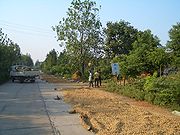
China is the world's largest producer and consumer of agricultural products – and some 300 million Chinese farm workers are in the industry, mostly laboring on pieces of land about the size of U.S farms. Virtually all arable land is used for food crops. China is the world's largest producer of rice and is among the principal sources of wheat, corn (maize), tobacco, soybeans, potatoes, sorghum, peanuts, tea, millet, barley, oilseed, pork, and fish. Major non-food crops, including cotton, other fibers, and oilseeds, furnish China with a small proportion of its foreign trade revenue. Agricultural exports, such as vegetables and fruits, fish and shellfish, grain and meat products, are exported to Hong Kong. Yields are high because of intensive cultivation, for example, China's cropland area is only 75% of the U.S. total, but China still produces about 30% more crops and livestock than the United States. China hopes to further increase agricultural production through improved plant stocks, fertilizers, and technology.
According to the government statistics issued in 2005, after a drop in the yield of farm crops in 2000, output has been increasing annually.
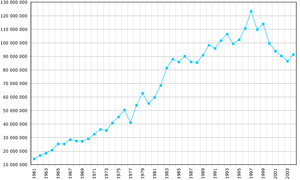
According to the United Nations World Food Program, in 2003, China fed 20 percent of the world's population with only 7 percent of the world's arable land. China ranks first worldwide in farm output, and, as a result of topographic and climatic factors, only about 10–15 percent of the total land area is suitable for cultivation. Of this, slightly more than half is unirrigated, and the remainder is divided roughly equally between paddy fields and irrigated areas. Nevertheless, about 60 percent of the population lives in the rural areas, and until the 1980s a high percentage of them made their living directly from farming. Since then, many have been encouraged to leave the fields and pursue other activities, such as light manufacturing, commerce, and transportation; and by the mid-1980s farming accounted for less than half of the value of rural output. Today, agriculture contributes only 13% of China's GDP.
Animal husbandry constitutes the second most important component of agricultural production. China is the world's leading producer of pigs, chickens, and eggs, and it also has sizable herds of sheep and cattle. Since the mid-1970s, greater emphasis has been placed on increasing the livestock output. China has a long tradition of ocean and freshwater fishing and of aquaculture. Pond raising has always been important and has been increasingly emphasized to supplement coastal and inland fisheries threatened by overfishing and to provide such valuable export commodities as prawns.
Environmental problems such as floods, drought, and erosion pose serious threats to farming in many parts of the country. The wholesale destruction of forests gave way to an energetic reforestation program that proved inadequate, and forest resources are still fairly meagre. The principal forests are found in the Qin Mountains and the central mountains and on the Sichuan–Yunnan plateau. Because they are inaccessible, the Qinling forests are not worked extensively, and much of the country's timber comes from Heilongjiang, Jilin, Sichuan, and Yunnan.
Western China, comprising Tibet, Xinjiang, and Qinghai, has little agricultural significance except for areas of floriculture and cattle raising. Rice, China's most important crop, is dominant in the southern provinces and many of the farms here yield two harvests a year. In the north, wheat is of the greatest importance, while in central China wheat and rice vie with each other for the top place. Millet and kaoliang (a variety of grain sorghum) are grown mainly in the northeast and some central provinces, which, together with some northern areas, also provide considerable quantities of barley. Most of the soybean crop is derived from the north and the northeast; corn (maize) is grown in the centre and the north, while tea comes mainly from the warm and humid hilly areas of the south. Cotton is grown extensively in the central provinces, but it is also found to a lesser extent in the southeast and in the north. Tobacco comes from the centre and parts of the south. Other important crops are potatoes, sugar beets, and oilseeds.
There is still a relative lack of agricultural machinery, particularly advanced machinery. For the most part the Chinese peasant or farmer depends on simple, non mechanized farming implements. Good progress has been made in increasing water conservancy, and about half the cultivated land is under irrigation.
In the late 1970s and early 1980s, economic reforms were introduced. First of all this began with the shift of farming work to a system of household responsibility and a phasing out of collectivized agriculture. Later this expanded to include a gradual liberalization of price controls; fiscal decentralization; massive privatization of state enterprises, thereby allowing a wide variety of private enterprises in the services and light manufacturing; the foundation of a diversified banking system (but with large amounts of state control); the development of a stock market; and the opening of the economy to increased foreign trade and foreign investment.
Industry and manufacturing

Industry and construction account for 46.8% of China's GDP. In 2009 around 8% of the total manufacturing output in the world came from China itself and China ranked third worldwide in industrial output that year (first was EU and second United States). Research by IHS Global Insight states that in 2010 China contributed to 19.8% of world's manufacturing output and became the largest manufacturer in the world that year, after the US had held that position for about 110 years.
In November, 2012 the State Council of the People's Republic of China mandated a "social risk assessment" for all major industrial projects. This requirement followed mass public protests in some locations for planned projects or expansions.
Major industries include mining and ore processing; iron and steel; aluminium; coal; machinery; armaments; textiles and apparel; petroleum; cement; chemical; fertilizers; food processing; automobiles and other transportation equipment including rail cars and locomotives, ships, and aircraft; consumer products including footwear, toys, and electronics; telecommunications and information technology. China has become a preferred destination for the relocation of global manufacturing facilities. Its strength as an export platform has contributed to incomes and employment in China.
Since the founding of the People's Republic, industrial development has been given considerable attention; as of 2011 46% of China's national output continued to be devoted to investment; a percentage far higher than any other nation. Among the various industrial branches the machine-building and metallurgical industries have received the highest priority. These two areas alone now account for about 20–30 percent of the total gross value of industrial output. In these, as in most other areas of industry, however, innovation has generally suffered at the hands of a system that has rewarded increases in gross output rather than improvements in variety, sophistication and quality. China, therefore, still imports significant quantities of specialized steels. Overall industrial output has grown at an average rate of more than 10 percent per year, having surpassed all other sectors in economic growth and degree of modernization. Some heavy industries and products deemed to be of national strategic importance remain state-owned, but an increasing proportion of lighter and consumer-oriented manufacturing firms are privately held or are private-state joint ventures.
The predominant focus of development in the chemical industry is to expand the output of chemical fertilizers, plastics, and synthetic fibers. The growth of this industry has placed China among the world's leading producers of nitrogenous fertilizers. In the consumer goods sector the main emphasis is on textiles and clothing, which also form an important part of China's exports. Textile manufacturing, a rapidly growing proportion of which consists of synthetics, account for about 10 percent of the gross industrial output and continues to be important, but less so than before. The industry tends to be scattered throughout the country, but there are a number of important textile centers, including Shanghai, Guangzhou, and Harbin.
Steel industry
In 2011 China was the largest producer of steel in the world producing 45% of the world's steel, 683 million tons, an increase of 9% from 2010. 6 of 10 of largest steel producers in the world are in China. Profits are low despite continued high demand due to high debt and overproduction of high end products produced with the equipment financed by the high debt. The central government is aware of this problem but there is no easy way to resolve it as local governments strongly support local steel production. Meanwhile, each firm aggressively increases production. Iron ore production kept pace with steel production in the early 1990s but was soon outpaced by imported iron ore and other metals in the early 2000s. Steel production, an estimated 140 million tons in 2000 increased to 419 million tons in 2006. Much of the country's steel output comes from a large number of small-scale producing centers, one of the largest being Anshan in Liaoning.
China was the top exporter of steel in the world in 2008. Export volumes in 2008 were 59.23 million tons, a 5.5% fall over the previous year. The decline ended China's decade-old steel export growth. As of 2012 steel exports faced widespread anti-dumping taxes and had not returned to pre-2008 levels. Domestic demand remained strong, particularly in the developing west where steel production in Xinjiang was expanding.
On April 26, 2012 a warning was issued by China's bank regulator to use caution with respect to lending money to steel companies who, as profits from the manufacture and sale of steel have fallen, have sometimes used borrowed money for speculative purposes. According to the China Iron and Steel Association the Chinese steel industry lost 1 billion Rmb in the first quarter of 2012, its first loss since 2000.
Automotive industry
By 2006 China had become the world's third largest automotive vehicle manufacturer (after US and Japan) and the second largest consumer (only after US). Automobile manufacturing has soared during the reform period. In 1975 only 139,800 automobiles were produced annually, but by 1985 production had reached 443,377, then jumped to nearly 1.1 million by 1992 and increased fairly evenly each year up until 2001, when it reached 2.3 million. In 2002 production rose to nearly 3.25 million and then jumped to 4.44 million in 2003, 5.07 million in 2004, 5.71 million in 2005, 7.28 million in 2006, 8.88 million in 2007, 9.35 million in 2008 and 13.83 million in 2009. China has become the number-one automaker in the world in 2009. Domestic sales have kept pace with production. After respectable annual increases in the mid- and late 1990s, passenger car sales soared in the early 2000s. In 2006, a total of 7.22 million automobiles were sold, including 5.18 million units of passenger cars and 2.04 million units of commercial vehicles.
In 2010, China became the world's largest automotive vehicle manufacturer as well as the largest consumer ahead of the United States with an estimated 18 million new cars sold. However, new car sales grew only by an estimated 1% between 2011 and 2012 due to the escalation in the Spratly Islands dispute which involved Japan, the world's third largest producer of vehicles.
China's automotive industry has been so successful that it began exporting car parts in 1999. China began to plan major moves into the automobile and components export business starting in 2005. A new Honda factory in Guangzhou was built in 2004 solely for the export market and was expected to ship 30,000 passenger vehicles to Europe in 2005. By 2004, 12 major foreign automotive manufacturers had joint-venture plants in China. They produced a wide range of automobiles, minivans, sport utility vehicles, buses, and trucks. In 2003 China exported US$4.7 billion worth of vehicles and components. The vehicle export was 78,000 units in 2004, 173,000 units in 2005, and 340,000 units in 2006. The vehicle and component export is targeted to reach US$70 billion by 2010.
The market for domestically produced cars, under a local name, is likely to continue to grow both inside China and outside. Companies such as Geely and Chery are constantly evaluating new international locations, both in developing and developed countries.
Other industries
Substantial investments were made in the manufacture of solar panels and wind generators by a number of companies, supported by liberal loans by banks and local governments. However, by 2012 manufacturing capacity had far outstripped domestic and global demand for both products, particularly solar panels which were subjected to anti-dumping penalties by both the United States and Europe. The global oversupply has resulted in bankruptcies and production cutbacks both inside and outside China. China has budgeted $50 billion to subsidize production of solar power over the two decades following 2015 but, even at the sharply reduced price resulting from oversupply, as of 2012 cost of solar power in China remained three times that of power produced by conventional coal-fired power plants.
China is the world's biggest sex toy producer and accounts for 70% of the worldwide sex toys production. In the country, 1,000 manufacturers are active in this industry, which generates about two billion dollars a year.
As of 2011, China was the world's largest market for personal computers
Services
China's services output in 2010 ranks third worldwide (after US and Japan), and high power and telecom density has ensured that it has remained on a high-growth trajectory in the long-term. In 2010 the services sector produced 43% of China's annual GDP, second only to manufacturing. However, its proportion of GDP is still low compared with the ratio in more developed countries, and the agricultural sector still employs a larger workforce. Prior to the onset of economic reforms in 1978, China's services sector was characterized by state-operated shops, rationing, and regulated prices. With reform came private markets and individual entrepreneurs and a commercial sector. The wholesale and retail trade has expanded quickly, with urban areas now having many shopping malls, retail shops, restaurant chains and hotels. Public administration has still remained a main component of the service sector, while tourism has become a significant factor in employment and as a source of foreign exchange. The potential for growing services in China through franchising is huge.
Telecommunications
China possesses a diversified communications system that links all parts of the country by Internet, telephone, telegraph, radio, and television.
China's number of Internet users or netizens topped 137 million by the end of 2006, an increase of 23.4% from a year before and 162 million by June 2007, making China the second largest Internet user after the United States, according to China's Ministry of Information Industry (MII). China's mobile phone penetration rate is 34% in 2007. In 2006, mobile phone users sent 429 billion text messages, or on average 967 text messages per user. For 2006, the number of fixed-lines grew by 79%, mainly in the rural areas.
Tourism
China's tourism industry is one of the fastest-growing industries in the national economy and is also one of the industries with a very distinct global competitive edge. The total revenue of China's tourism industry reached USD 67.3 billion in 2002, accounting for 5.44% of the GDP. The total number of inbound tourists was 91.66 million in 2003. International tourism receipts were USD 17.4 billion in 2003.
China's domestic tourism market makes up more than 90% of the country's tourism traffic, and contributes more than 70% of total tourism revenue. In 2002, domestic tourists reached 878 million and tourism revenue was USD 46.9 billion. A large middle class population with strong consumption power is emerging in China, especially in major cities. China's outbound tourists reached 20.22 million in 2003, overtaking Japan for the first time.
It is forecast by the WTO that China's tourism industry will take up to 8.6% of world market share to become the world's top tourism industry by 2020.
Chinese business-travel spend is also forecast to be the highest in the world by 2014, overtaking the United States. According to a Global Business Travel Association study, total business-travel spend is expected to reach US$195 billion in 2012.
Luxury goods
A factor that often goes overlooked is the extent of luxury spending the Chinese citizenry are undertaking. There is no greater indication of the newfound wealth of the Chinese than the amount of money now spent on goods and services that were once inaccessible. Foremost among these is the shift towards bottled water. The Chinese bottled water manufacturing industry is forecast to more than double in size in 2008, becoming a $10.5 (US dollars) billion industry in the process. Meanwhile, as those who once had no recourse but poor-quality tap water take advantage of its availability in supermarkets, those who had little or no running water are now capitalising on its availability. The tap water production and supply industry is expected to grow by 29.3% in 2008, to $11.9 billion. The country's motor vehicle production industry is expected to expand by 29.5% to nearly $200 billion, as many Chinese eschew traditional modes of transport, such as bicycles, for the comforts of modern cars. Also, consumption of chocolate and other confectionery is set to increase by 24.3%, as the industry expands to $4.6 billion, in order to keep up with China's collective sweet tooth. Couple with this is 20.8% growth in China's fast food industry, as major players such as McDonald's enter the country with vigour. Also, the LVMH Group, who own major luxury brands including Louis Vuitton apparel, Moët & Chandon wines and champagne and Hennessy cognacs, reported earnings growth of over 25% in 2007 in China, the region now accounting for around 16% of their global business.
Following a ban instituted in October, 2012 on government agencies purchasing luxury goods, often used as "gifts", sales of luxury goods in China remained strong, but slowed, even falling slightly for some luxury retailers in the 4th quarter of 2012.
Retail sales in China account for only 7% of global retail sales of luxury consumer goods; however, Chinese buyers account for 25% of global retail sales of luxury consumer goods. Many shops in international travel destinations have specialized staff devoted to Chinese customers.
Cybercrime
Computer crime is an important sector of the Chinese economy, directly employing 90 thousand people and impacting the lives of 110 million.
Labor and welfare

One of the hallmarks of China's socialist economy was its promise of employment to all able and willing to work and job-security with virtually lifelong tenure. Reformers targeted the labor market as unproductive because industries were frequently overstaffed to fulfill socialist goals and job-security reduced workers' incentive to work. This socialist policy was pejoratively called the iron rice bowl.
In 1979–1980, the state reformed factories by giving wage increases to workers, which was immediately offset by sharply rising inflation rates of 6–7%. The reforms also dismantled the iron rice bowl, which meant it witnessed a rise in unemployment in the economy. In 1979 there were 20 million unemployed people. Official Chinese statistics reveal that 4.2% of the total urban workforce was unemployed in 2004, although other estimates have reached 10%. As part of its newly developing social security legislation, China has an unemployment insurance system. At the end of 2003, more than 103.7 million people were participating in the plan, and 7.4 million laid-off employees had received benefits.
China's estimated employed labor force in 2005 totaled 791.4 million persons, about 60% of the total population. During 2003, 49% of the labor force worked in agriculture, forestry, and fishing; 22% in mining, manufacturing, energy, and construction industries; and 29% in the services sector and other categories. In 2004 some 25 million persons were employed by 743,000 private enterprises. Urban wages rose rapidly from 2004 to 2007, at a rate of 13 to 19% per year with average wages near $200/month in 2007.
The All-China Federation of Trade Unions (ACFTU) was established in 1925 to represent the interests of national and local trade unions and trade union councils. The ACFTU reported a membership of 130 million, out of an estimated 248 million urban workers, at the end of 2002. Chinese trade unions are organized on a broad industrial basis. Membership is open to those who rely on wages for the whole or a large part of their income, a qualification that excludes most agricultural workers.
In 2010, the issues of manufacturing wages caused a strike at a Honda parts plant. This resulted in wage increases both at the struck plant and other industrial plants.
The 2010 census found that the PRC was now half urban and rapidly aging due to the one child policy. This is expected to lead to increased demand for labor to take care of an elderly population and a reduced supply of migrant labor from the countryside.
A law approved February 2013 will mandate a nationwide minimum wage at 40% average urban salaries to be phased in fully by 2015.
External trade
International trade makes up a sizeable portion of China's overall economy. Being a Second World country at the time, a meaningful segment of China's trade with the Third World was financed through grants, credits, and other forms of assistance. The principal efforts were made in Asia, especially to Indonesia, Burma, Pakistan, and Ceylon, but large loans were also granted in Africa (Ghana, Algeria, Tanzania) and in the Middle East (Egypt). However, after Mao Zedong's death in 1976, these efforts were scaled back. After which, trade with developing countries became negligible, though during that time, Hong Kong and Taiwan both began to emerge as major trading partners.
Since economic reforms began in the late 1970s, China sought to decentralize its foreign trade system to integrate itself into the international trading system. On November 1991, China joined the Asia-Pacific Economic Cooperation (APEC) group, which promotes free trade and cooperation the in economic, trade, investment, and technology spheres. China served as APEC chair in 2001, and Shanghai hosted the annual APEC leaders meeting in October of that year.
After reaching a bilateral WTO agreement with the EU and other trading partners in summer 2000, China worked on a multilateral WTO accession package. China concluded multilateral negotiations on its accession to the WTO in September 2001. The completion of its accession protocol and Working Party Report paved the way for its entry into the WTO on December 11, 2001, after 16 years of negotiations, the longest in the history of the General Agreement on Tariffs and Trade. However, U.S. exporters continue to have concerns about fair market access due to China's restrictive trade policies and U.S. export restrictions.
China's global trade exceeded $2.4 trillion at the end of 2008. It first broke the $100 billion mark in 1988, $200 billion in 1994, $500 billion in 2001 and $1 trillion mark ($1.15 trillion) in 2004. The table below shows the average annual growth (in nominal US dollar terms) of China's foreign trade during the reform era.
| Period | Two-way trade | Exports | Imports |
|---|---|---|---|
| 1981–85 | +12.8% | +8.6% | +16.1% |
| 1986–90 | +10.6% | +17.8% | +4.8% |
| 1991–95 | +19.5% | +19.1% | +19.9% |
| 1996–2000 | +11.0% | +10.9% | +11.3% |
| 2000–05 | +24.6% | +25.0% | +24.0% |
| 2006-10 | +15.9% | +15.7% | +16.1% |
| 2011 | +22.5% | +20.3% | +24.9% |
The vast majority of China's imports consists of industrial supplies and capital goods, notably machinery and high-technology equipment, the majority of which comes from the developed countries, primarily Japan and the United States. Regionally, almost half of China's imports come from East and Southeast Asia, and about one-fourth of China's exports go to the same destinations. About 80 percent of China's exports consist of manufactured goods, most of which are textiles and electronic equipment, with agricultural products and chemicals constituting the remainder. Out of the five busiest ports in the world, three are in China. The U.S. trade deficit with China reached $232.5 billion in 2006, as imports grew 18%. China's share of total U.S. imports has grown from 7% to 15% since 1996.
Trade volume between China and Russia reached $29.1 billion in 2005, an increase of 37.1% compared with 2004. A spokesman for the Ministry of Commerce, Van Jingsun, said that the volume of trade between China and Russia could exceed 40 billion dollars in 2007. China's export of machinery and electronic goods to Russia grew 70%, which is 24% of China's total export to Russia in the first 11 months of 2005. During the same time, China's export of high-tech products to Russia increased by 58%, and that is 7% of China's total exports to Russia. Also in this time period border trade between the two countries reached $5.13 billion, growing 35% and accounting for nearly 20% of the total trade. Most of China's exports to Russia remain apparel and footwear. Russia is China's eighth largest trade partner and China is now Russia's fourth largest trade partner, and China now has over 750 investment projects in Russia, involving $1.05 billion. China's contracted investment in Russia totaled $368 million during January–September 2005, twice that in 2004.
Chinese imports from Russia are mainly those of energy sources, such as crude oil, which is mostly transported by rail, and electricity exports from neighboring Siberian and Far Eastern regions. In the near future, exports of both of these commodities are set to increase, as Russia is building the Eastern Siberia-Pacific Ocean oil pipeline with a branch to Chinese border, and Russian power grid monopoly UES is building some of its hydropower stations with a view of future exports to China.
Export growth has continued to be a major component supporting China's rapid economic growth. To increase exports, China pursued policies such as fostering the rapid development of foreign-invested factories, which assembled imported components into consumer goods for export and liberalizing trading rights. In its 11th Five-Year Program, adopted in 2005, China placed greater emphasis on developing a consumer demand-driven economy to sustain economic growth and address imbalances.
Trading partners
Foreign investment
China's investment climate has changed dramatically with more than two decades of reform. In the early 1980s, China restricted foreign investments to export-oriented operations and required foreign investors to form joint-venture partnerships with Chinese firms. The Encouraged Industry Catalogue sets out the degree of foreign involvement allowed in various industry sectors. From the beginning of the reforms legalizing foreign investment, capital inflows expanded every year until 1999. Foreign-invested enterprises account for 58–60% of China's imports and exports.
Since the early 1990s, the government has allowed foreign investors to manufacture and sell a wide range of goods on the domestic market, eliminated time restrictions on the establishment of joint ventures, provided some assurances against nationalization, allowed foreign partners to become chairs of joint venture boards, and authorized the establishment of wholly foreign-owned enterprises, now the preferred form of FDI. In 1991, China granted more preferential tax treatment for Wholly Foreign Owned Enterprises and contractual ventures and for foreign companies, which invested in selected economic zones or in projects encouraged by the state, such as energy, communications and transportation.
China also authorized some foreign banks to open branches in Shanghai and allowed foreign investors to purchase special "B" shares of stock in selected companies listed on the Shanghai and Shenzhen Securities Exchanges. These "B" shares sold to foreigners carried no ownership rights in a company. In 1997, China approved 21,046 foreign investment projects and received over $45 billion in foreign direct investment. China revised significantly its laws on Wholly Foreign-Owned Enterprises and China Foreign Equity Joint Ventures in 2000 and 2001, easing export performance and domestic content requirements.
Foreign investment remains a strong element in China's rapid expansion in world trade and has been an important factor in the growth of urban jobs. In 1998, foreign-invested enterprises produced about 40% of China's exports, and foreign exchange reserves totalled about $145 billion. Foreign-invested enterprises today produce about half of China's exports (the majority of China's foreign investment come from Hong Kong, Macau and Taiwan), and China continues to attract large investment inflows. However, the Chinese government's emphasis on guiding FDI into manufacturing has led to market saturation in some industries, while leaving China's services sectors underdeveloped. From 1993 to 2001, China was the world's second-largest recipient of foreign direct investment after the United States. China received $39 billion FDI in 1999 and $41 billion FDI in 2000. China is now one of the leading FDI recipients in the world, receiving almost $80 billion in 2005 according to World Bank statistics. In 2006, China received $69.47 billion in foreign direct investment.
Foreign exchange reserves totaled $155 billion in 1999 and $165 billion in 2000. Foreign exchange reserves exceeded $800 billion in 2005, more than doubling from 2003. Foreign exchange reserves were $819 billion at the end of 2005, $1.066 trillion at the end of 2006, $1.9 trillion by June 2008. In addition, by the end of September 2008 China replaced Japan for the first time as the largest foreign holder of US treasury securities with a total of $585 billion, vs Japan $573 billion. China has now surpassed those of Japan, making China's foreign exchange reserves the largest in the world.
As part of its WTO accession, China undertook to eliminate certain trade-related investment measures and to open up specified sectors that had previously been closed to foreign investment. New laws, regulations, and administrative measures to implement these commitments are being issued. Major remaining barriers to foreign investment include opaque and inconsistently enforced laws and regulations and the lack of a rules-based legal infrastructure. Warner Bros., for instance, withdrew its cinema business in China as a result of a regulation that requires Chinese investors to own at least a 51 percent stake or play a leading role in a foreign joint venture.
Chinese investment abroad
Outward foreign direct investment is a new feature of Chinese globalization, where local Chinese firms seek to make investments in both developing and developed countries. It was reported in 2011 that there was increasing investment by capital rich Chinese firms in promising firms in the United States. Such investments offer access to expertise in marketing and distribution potentially useful in exploiting the developing Chinese domestic market.
Mergers and acquisitions
From 1993 to 2010, Chinese companies have been involved as either an acquiror or acquired company in 25,284 mergers and acquisitions with a total known value of US$969 billion. The number and value of deals hit a new record in 2010. The number of deals that happened in 2010 has been 3,640 which is an increase of 17% compared to 2009. The value of deals in 2010 was US$196 billion which is an increase of 25% compared to the year before.
Demographics
Since the 1950s medical care, public hygiene and sanitation improved considerably, and epidemics were controlled. Consecutive generations continuously experienced better health. The population growth rate surged as the mortality rate dropped more rapidly than the birth rate. China's massive population has always been a major difficulty for the government as it has struggled to provide for it. In the 1950s, food supply was inadequate and the standard of living was generally low. This spurred the authorities to initiate a major birth control program. The Great Leap Forward industrial plan in 1958–60 was partially responsible for a huge famine that caused the death rate to surpass the birth rate, and by 1960, the overall population was declining. A second population control drive began in 1962 with major efforts focused on promoting late marriages and the use of contraceptives. By 1963 the country was in the beginning of recovery from the famine and the birth rate soared to its highest since 1949 with an annual population growth rate of 3%. In 1966, the Cultural Revolution suspended this second family planning program, but resumed four years later with the third attempt by making later marriage and family size limitation an obligation. Since 1970, the efforts have been much more effective. The third family planning program continued until 1979 when the one child per family policy was implemented. By the early 1980s, China's population reached around 1 billion and by the early 2000s, surpassed 1.3 billion. In the 1980s, the average overall population growth was around 1.5%. In the 1990s, this fell to about 1%. Today it is about 0.6%. China's population growth rate is now among the lowest for a developing country, although, due to its large population, annual net population growth is still considerable. One demographic consequence of the one-child policy is that China is now one of the most rapidly ageing countries in the world.
From 100 million to 150 million surplus rural workers are adrift between the villages and the cities, many subsisting through part-time, low-paying jobs.
According to the latest Forbes China Rich List (2007), China had 66 billionaires, the second largest number after the United States, which had 415. In the 2006 Forbes Rich List it stated that there were 15 Chinese billionaires. In the latest 2007 Hurun Report, it lists 106 billionaires in China.
Labor force
In 2012, for the first time, according to statistics released by China's National Bureau of Statistics in January, 2013, the size of the labor force, people aged 15 to 59, in China shrank slightly to 937.27 million people, a decrease of 3.45 million from 2011. This trend, resulting from China's successful one-child policy of population control, is anticipated to continue for at least the next 20 years, to 2030.
Transportation and infrastructure
Development of the country's transportation infrastructure is given a high priority because it is so strategically tied to the national economy and national defense. Regardless, the transportation infrastructure is still not fully developed in many aspects and areas, and it constitutes a major hindrance on economic growth and the efficient logistical movement of goods and people. China's transportation policy, influenced by political, military, and economic concerns, have undergone major changes since 1949.
Immediately after the People's Republic was founded, the primary goal was to repair existing transportation infrastructure in order to meet military transport and logistics needs as well as to strengthen territorial integrity. During most of the 1950s, new road and rail links were built, while at the same time old ones were improved. During the 1960s much of the improvement of regional transportation became the responsibility of the local governments, and many small railways were constructed. Emphasis was also placed on developing transportation in remote rural, mountainous, and forested areas, in order to integrate poorer regions of the country and to help promote economies of scale in the agricultural sector.
Before the reform era began in the late 1970s, China's transportation links were mostly concentrated in the coastal areas and access to the inner regions was generally poor. This situation has been improved considerably since then, as railways and highways have been built in the remote and frontier regions of the northwest and southwest. At the same time, the development of international transportation was also pursued, and the scope of ocean shipping was broadened considerably.
Freight haulage is mainly provided by rail transport. The rail sector is monopolized by China Railways, which is controlled by the Ministry of Railways and there is wide variation in services provided. In late 2007 China became one of the few countries in the world to launch its own indigenously developed high-speed train. As rail capacity is struggling to meet demand for the transport of goods and raw materials such as coal, air routes, roads and waterways are rapidly being developed to provide an increasing proportion of China's overall transportation needs.
Some economic experts have argued that the development gap between China and other emerging economies such as Brazil, Argentina and India can be attributed to a large extent to China's early focus on ambitious infrastructure projects: while China invested roughly 9% of its GDP on infrastructure in the 1990s and 2000s, most emerging economies invested only 2% to 5% of their GDP. This considerable spending gap allowed the Chinese economy to grow at near optimal conditions while many South American economies suffered from various development bottlenecks (poor transportation networks, aging power grids, mediocre schools...).
Science and technology
Science and technology in the People's Republic of China has in recent decades developed rapidly. The Chinese government has placed emphasis through funding, reform, and societal status on science and technology as a fundamental part of the socio-economic development of the country as well as for national prestige. China has made rapid advances in areas such as education, infrastructure, high-tech manufacturing, academic publishing, patents, and commercial applications and is now in some areas and by some measures a world leader. China is now increasingly targeting indigenous innovation and aims to reform remaining weaknesses.
Environment and public health
One of the serious negative consequences of China's rapid industrial development since the 1980s has been increased pollution and degradation of natural resources. Problems such as soil erosion, desertification and the steady fall of the water table, especially in the north, have posed a threat to the sustainable development of the country. China is an active participant in climate change talks and other multilateral environmental negotiations in organization such as the UN Environment Program (UNEP).
